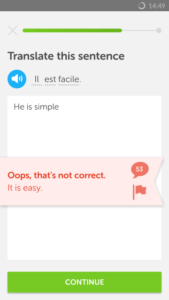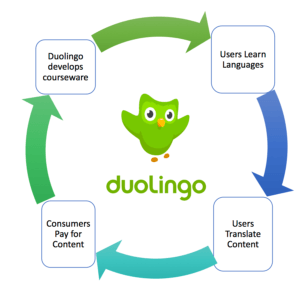Duolingo: Using the Wisdom of Crowds to Translate Language

Duolingo operates in a smart “twofer” model – offering free language courseware while monetizing the crowd-sourced content translated by its users.
Language-learning AND Crowd-sourced Translation?
Duolingo, a free language learning platform, was built upon a project started at the end of 2009 by CMU professor Luis von Ahn (creator of reCAPTCHA) and his graduate student…the idea is to create a program that served two purposes, a “twofer” as Luis von Ahn said, teaching its users a foreign language while having them translate simple phrases in documents [1].
Most of us have heard of the free platform of language-learning but few really know how Duolingo monetizes the content generated by language-learners.
Value Creation
Free and Convenient – Duolingo offers high-quality language courseware for free, which is a nice alternative to traditional language-learning spending hundred-dollars and sitting in a classroom. The software is available in both desktop and mobile version across multiple operating platforms. As Duolingo expands, millions of users now can conveniently access and learn more than thirty languages on its platform, anytime and anywhere.
Gamification and Network Effect – Its gamification features certainly make learning more interactive and fun. Vocabularies are categorized into different themes such as Food and Travel which offers utilitarian value. User learn in variety of content formats including pictures, sentence translation and speaking exercises. Once you hit your learning goal with limited tries, you will be awarded new badges and gain experience points. There is also a network effect as users are also encouraged to share progress with friends and learning community.

Value Capture
The real dilemma is how would companies make money if the content is free? Well, someone has put it nicely – if you are not paying for the product, then you are the product!
Translation Service – Duolingo turns users into “workforce” and every translation practice done by user produces a piece of a translation product that Duolingo could monetize. Specifically, Duolingo would have multiple users translate the same sentence; software compares those results to settle on a final translation. After many sentences are put through this process, they are combined to create a translation of an entire document. The results, says von Ahn, are better than an automated translation but typically just short of professional quality.[2] Duolingo has announced partnerships with BuzzFeed and CNN to have their content translated by Duolingo’s community of language learners. The service is much cheaper than current professional translation and provides an interesting option for social contents that are easier translate and requires less accuracy.
Language Test – Duolingo also captures value from the $49 language test, which is to compete with the many $200 language tests out there. According to the company, this test is now accepted by many prestigious universities. [3]
Incentivizing and Managing the crowd
Duolingo has experimented with rewarding experience points and introducing a rating system to encourage participation in translation exercise. However, some users found the current scheme less motivating as there is nothing that really shows how much you have contributed to translating versus points collected from participating regular lessons. [4]
I would say, for the most part, learning is the primary motive. There isn’t any monetary reward or social recognition for users performing translation tasks. The only incentives for users to participate in translation is the opportunity to learn new languages for free while Duolingo keeps innovating on gamification features and better product experience.
Challenges
User Participation – I wonder if the current scheme is enough to keep users engaged and deliver high-quality translations. As more users get familiar with Duolingo’s business model, more would demand to see an explicit link between the reward and their contribution in translation. How could Duolingo make the process from selecting and blending translation works from different users to attributing contribution and rewards properly, so as to create a virtuous cycle?
Quality and Timeliness – If Duolingo continues to expand and establish partnership with news and social media companies, speed to delivery and quality of translated content would be a key to success. How should Duolingo leverage technology to improve accuracy of translation and properly match supply and demand in a timely manner?
Moving Forward
In July 2017, the company raised a $25 million Series E round.[6] As the founder once said, Duolingo decided its purpose was teaching, not translation. I remain curious about the next move Duolingo takes – growing its business while making language learning accessible for everyone.
Sources:
[1] https://en.wikipedia.org/wiki/Duolingo
[2] https://unicornomy.com/how-does-duolingo-make-money-business-model/
[3] www.duolingo.com
[4] https://www.duolingo.com/comment/1032964/Reward-for-Translating
[5] https://www.technologyreview.com/s/506656/the-cleverest-business-model-in-online-education/
[6] https://techcrunch.com/2017/07/25/duolingo-raises-25m-at-a-700m-valuation/
[7] https://www.fastcompany.com/3027354/the-founder-of-duolingo-tells-us-the-secret-to-creating-value-from-chaos
Photo Credit:
Conor Walsh
www.windowsmode.com





This is so interesting, I’ve used Duolingo and I had no idea that they were also monetizing the translation content. Another challenge is that I wonder if Duolingo will hit a ceiling in the level or style of language that they can have translated by users. One of the things I appreciated about the app as a user is that the text and phrases seemed very applicable to content I would need as a tourist or beginner-level speaker. If they are working with companies like Buzzfeed, I wonder if it would feel forced to the user to have those types of phrases appear in lessons.
I myself was surprised to learn about their monetization model – very smart and interesting! To your point about the type of content Duolingo should choose for users to translate, I agree that they should act under the premise that it still contributes to user’s learning experience in a natural way. Mechanisms to filter suitable content or to create more categories/themes that would fit with different content should be something they have to keep in mind when monetizing translations.
Great post KZ! I agree with you that one of the biggest challenges they will face as they acquire demanding clients is translation quality. It seems that the users that get the most value out of the product are those with limited mastery of the language. Those users that learn the language leave the platform or switch to more sophisticated learning methods such as hiring a tutor. To improve translation quality they would either need to retain advanced users, increase the number of translation attempts per word (play the numbers game) or invest in the software to improve its accuracy.
I agree. I also think it would be interesting to learn the data of 1)% user graduating to next level each month, 2) user churn rate% and 3) participation in translation by each level to identify who are the hyper-engaged user and how to retain them.
Love this post! I’m a huge fan of Duo Lingo. I feel that the post is a little harsh on them, though. I think they are doing a pretty great job! Currently the free version has ads that are annoying enough that I’m considering paying. I also paid $4 to keep my streak alive (just part of the game of it) because of 1) the gamification and 2) the wording that had around “supporting their mission”. I really hope they stick with the mission as it’s a huge part of why I stick with them and don’t seek out another similar language learning app. I personally think they could go farther with the gamification and give longer term rewards for keeping up with languages even if you’ve become fluent. For instance, right now you win “gems” when you keep a weeklong streak, but what about a month? Or what if I’ve just stuck with the app for a long period of time but not necessarily a streak? I think building on power of a long term commitment/investment with the app could be really smart and drive more monetary value (in ads or in direct payment) from users.
Great to see another von Ahn post!
I’d be really interested to hear your thoughts on why this ‘twofer’ business model has not been created more often.
P.S. I originally came across von Ahn and his work in the book Big Data (https://www.amazon.com/Big-Data-Revolution-Transform-Think/dp/054422775). If you haven’t read it, I would highly recommend it.
Bummer! The link is expired.. but I’ll definitely add that to my books list. I also find von Ahn a great innovator and wanted to learn more.
Thank you very much for your post KZ. The Duolingo business model is fascinating. I think it’s very impressive that they were able to leverage language learners to translate bits and pieces of content from BuzzFeed and CNN as each learner will have the different context in mind while translating. I think this is part of the reason why your argument is valid. Duolingo will need to have a large enough pool of language learners to be able to effectively translate content. Furthermore, they will always need a pool of capable learner to be able to create a high-quality translation. But these high-quality learners are the people who will either leave the platform or demand payment.